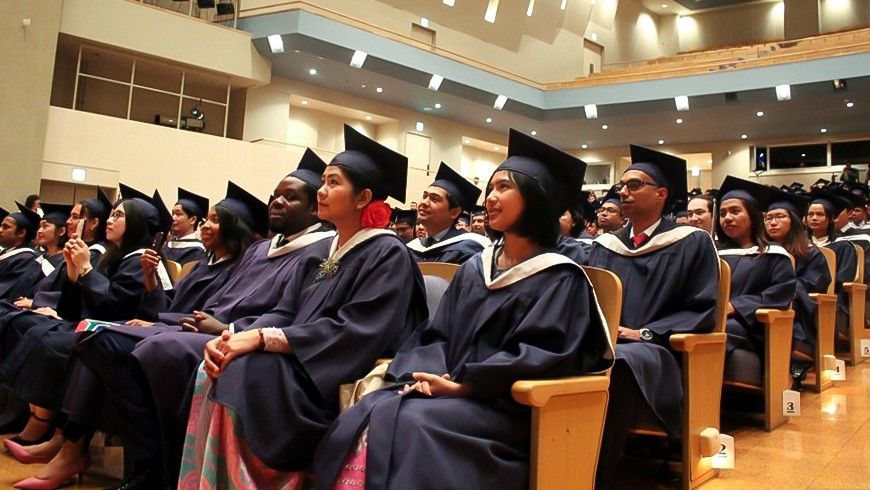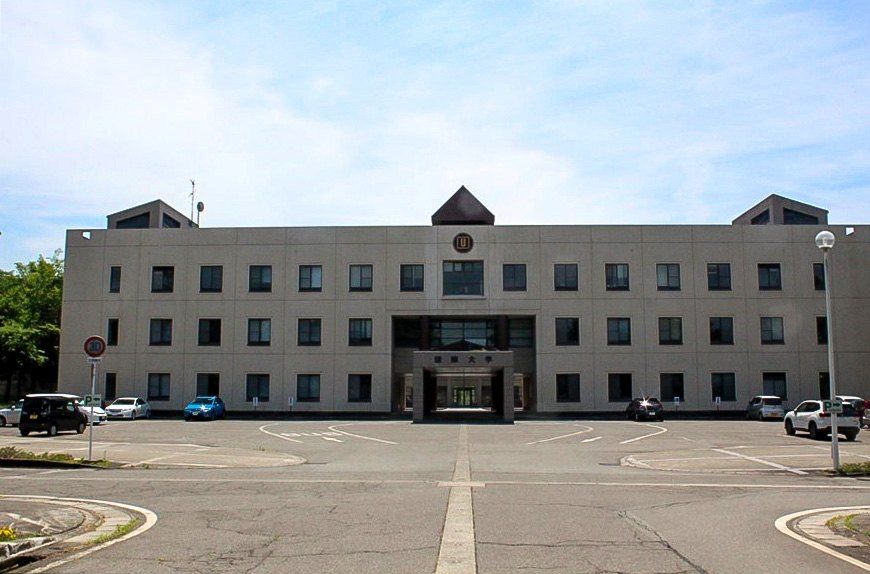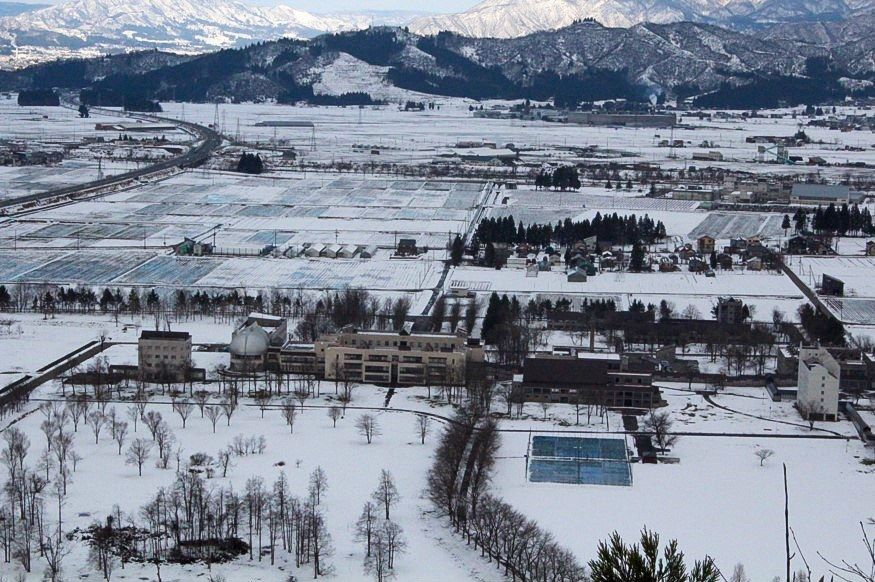
Missed Opportunities in Japan’s “International Town”
Society Culture Education- English
- 日本語
- 简体字
- 繁體字
- Français
- Español
- العربية
- Русский
An International University in the Countryside
The word “international” (kokusai in Japanese) has become a ubiquitous part of life in contemporary society. As well as appearing in newspapers on a daily basis, the word is routinely found in the names of everything from airports and schools to railway stations, hospitals, and companies of every conceivable kind.
But place names that feature the word are much harder to find. In fact, there are only three in the whole country. Two of them are officially “villages”: Shōnan Kokusaimura in Kanagawa Prefecture and Kamiyama Kokusaimura in Nagano Prefecture. The country’s only international “town” is Kokusaichō, officially part of Minamiuonuma in Niigata Prefecture. It dates back to 1982, when Japan’s first international university was founded here on 16 hectares of agricultural land.
The country’s political and business leaders saw that Japan was going to need a more internationalized workforce to adapt to a globalizing world in the years to come. A decision was taken to establish the International University of Japan in Minamiuonuma to provide English-language graduate-level training in international relations, business management and other subjects. The idea was to make society more “internationalized” by bringing Japanese corporate employees and foreign students together to live and study under the same roof.

The International University of Japan.
This was a major undertaking, carried out with the full support of the government, as part of a national project. Senior politicians and prominent business figures were appointed to positions of leadership within the new institution: Nakayama Sohei, former chairman of the Japan Association of Corporate Executives became the school’s first chairman, and former Foreign Minister Ōkita Saburō the first president.
Today, around 300 international students, faculty, and their families live in the “international town,” representing no fewer than 57 countries and regions, including Somalia, Lesotho, Swaziland, East Timor, Tajikistan, and Fiji. In some cases, there are only a few dozen people from these countries in the whole of Japan. This makes this small town in the Japanese countryside one of the most diverse places in the nation. Indeed, such a degree of diversity would be unusual anywhere in the world.
Most of the faculty hold doctorates from universities in Europe and North America. In 2019, the university was the only Japanese institution to win a place in the Economist ranking of international business schools, coming 94th worldwide and 6th in Asia.
Unfortunately, this uniquely diverse setting has recently been the scene for two incidents of discrimination.
Prejudice Rears its Ugly Head
On March 11, 2019, a member of the university faculty posted on the university’s internal server a discriminatory complaint by a student about the “bad body odor” of African students. Underneath the student’s “complaint” was a reply from a faculty member that seemed to endorse or least condone the discrimination, saying: “Please tell me their name and I will talk to them privately.” The media picked up on the incident in June and the university issued an apology.
Just days before this, on March 9, the mayor of Minamiuonuma, Hayashi Shigeo, visited the university. The “international town” had been designated as a possible site for a new waste processing facility, and the mayor was visiting to explain the plans to students and faculty. But the English explanation he brought with him consisted of just 19 pages, much shorter than the Japanese version of the text, which ran to 65 pages.
On November 15, a volunteer group representing residents of Kokusaichō submitted a petition signed by 403 current students and alumni of the university demanding that plans for the facility be scrapped. The petition complained that people in Kokusaichō “were not receiving equal treatment as residents,” and demanded a written reply by December 20.
On November 20, a local news show ran a special report on the situation. Asked to account for the difference in volume of explanatory materials, Mr. Hayashi replied: “They’re only here for two years or so. The waste facility won’t be finished for seven years. To tell the truth, it’s kind of absurd to go there and provide an explanation on the same level as we’ve given to full-time local residents. But we went out of our way to organize a meeting for them anyway.” So far, there has not been any response to the petition. Students are organizing an online petition drive demanding the mayor to retract his discriminatory remarks against foreigners.
Some faculty and their families have lived in Kokusaichō for a decade or more. Many students spend five years or more here obtaining their PhDs. To suggest that these people are not entitled to the same rights and explanations from the mayor as other residents contradicts the facts, and is discriminatory in itself.
Ignoring the Wishes of Residents
How did it come about that incidents of discrimination could take place on the campus of a university that was supposed to play a leading role in making Japanese society more open to the wider world?
The biggest reason is that there are only limited opportunities for residents of Kokusaichō to make their views known to the local government. One of the major roles of administrators is to gather the opinions of residents on important issues. But in the case of Kokusaichō, the city hall generally communicates with students and faculty via the university offices.
The people who work in the university offices are not residents of Kokusaichō. The president and chairman of the university, who have the ultimate powers to make decisions, live in Tokyo. The current chairman was previous chairman of the board at Mitsui & Co., while the president is an emeritus professor at Hitotsubashi University. As things stand, the senior management of a private university is standing between the residents and city hall.
The plans for the waste facility propose that the city will acquire 9 hectares of the International University’s land, 5.5 of which will be used to build the new waste processing plant. Bathing facilities and other buildings will be constructed on the rest of the land, and the city will supply electricity to the university using energy produced from the waste processing. The university therefore has vested interests in the deal. For the city to use the university as an intermediary in providing information about the scheme to the residents who live closest to the proposed site lacks neutrality.
Originally, the university told local government officials that there was “no need” for a meeting to discuss the proposal with residents of Kokusaichō. When the university later changed its mind and decided to hold a meeting after all, the chosen date clashed with the university sports day. In the email it sent to students, the university also failed to include accurate information about where the waste facility would be located—even though the proposed facility would be built close to student dormitories, creating an eyesore that students would have to live with every day. In the end, only 12 people attended the meeting. And although the mayor has held numerous meetings throughout the area and minutes of city council meetings have been released to the public, no full-scale meeting, complete with interpreters, has yet been held for residents of Kokusaichō.
Isolation in the Countryside
How did a university of this kind come to be built in the mountains of Niigata in the first place?
The current population of the municipality stands at around 14,000 people. Despite the small size of its population, the area is far from a mundane provincial backwater. In addition to the International University, it is home to Urasa Station on the Jōetsu shinkansen line; the Kitasato Junior College of Health and Hygienic Sciences, an important training college for nurses and dieticians; Kokusai Jōhō High School, one of the most prestigious and competitive schools in the prefecture; and the Uonuma Kikan Hospital, with 400 patient beds.
In front of Urasa Station is a statue of former Prime Minister Tanaka Kakuei, his right arm pointing optimistically into the sky. This part of the country was one of the major centers of Tanaka’s political support, and a base for the Etsuzankai group that backed him throughout his career. This support brought its rewards in the form of numerous infrastructure projects. The first mayor of Minamiuonuma was a Tanaka supporter who had come up through the ranks of the Etsuzankai group. The current mayor, his designated successor, took office in 2016.
The reason that the International University owned 16 hectares of spare land in the first place is simple. The original plan was to use this land for new departments and a high school as the university expanded in the future. But these ambitious ideas were abandoned when the Japanese economic bubble burst. Originally, more than half of the students at the university were employees sent by their Japanese companies, but Japanese now make up less than 10% of the student body. Today, more than half of all the students are trainees who have come as part of Japan’s official development aid to developing countries. Their airfares, living costs, and school fees are covered by tax-funded scholarships. The tuition and living expenses alone for a single student come to around ¥3.6 million a year. The International University is a private university where tuition costs around ¥2 million a year—although the high proportion of government-funded overseas students has led to a joke that the university is “privately founded but publically funded.”
If you come to Japan on the trainee program, you are not allowed to drive. Unfortunately, the rural area around the International University is one that is almost totally built around cars. The campus is in the heart of the “snow country,” and during winter in particular it is difficult to get anywhere without a car. The nearest station is a 40-minute walk away. Restaurants and bars are 15 minutes away, and it is 20 minutes to the nearest convenience store. The main lifeline for students is a shuttle bus that runs once an hour along a loop taking in the station and other important places in and around campus. (On weekends there are just two buses a day.)

The campus and its surroundings in winter.
Many students are government officials or employees with major companies in their home countries, obliged to return home after their two-year period as a “trainee” comes to an end. They have little time or incentive to study Japanese.
And so, in a place where everyone else owns a car and few people speak English, the university has become an island in the middle of the countryside, an isolated mini-community of students who generally cannot speak Japanese and do not hold driving licenses. Students joke that the letters IUJ stand not for “International University of Japan” but “Isolated University of Japan.”
The two communities live almost totally separate lives and know next to nothing about each other. Most locals would be hard pressed to name the university president, while many foreign students return home after living here for two years or more without ever hearing the name of the famous local Koshihikari rice.
Dormitory rooms for single students are generously sized—around 15 square meters—with toilet and shower attached. Some students cook their own meals in the shared kitchen, while others eat in the university cafeteria. The library is open till midnight, and the computer center stays open around the clock. Many students study till late at night. Their entire daily lives take place on campus.
One foreign student confessed that spending so much time cooped up on campus leads to psychological stress, and that many people struggle with feelings of loneliness and isolation and find it difficult to form relationships.
Certainly, few students build friendships with local residents. I spoke to one man in his forties who lives within a five-minute walk of the university. He told me that he often used to visit the university when he was young to play with the children of the Japanese students. “But not many people there can speak Japanese now,” he said, “so I hardly have any reason to visit nowadays.”
It seems likely that the pressure of isolation has started to impact students’ relationships with one another, and that this may have contributed to the discriminatory statement described above.
Tapping Students’ Desire to Participate in Local Life
Despite these challenges, the residents of Kokusaichō are doing what they can to become a more integrated part of the local community.
In May 2018, I launched the Uonuma Network Group on Facebook, with the hope of encouraging more interaction and exchanges between students and long-term residents. The group currently has 730 members.
When I translated invitations for volunteers for things like snow clearing and emergency aid into English and posted them on the group, many international students put themselves forward. During the torrential rains and flooding that hit parts of western Japan in July 2018, one student from Nigeria traveled to Hiroshima for a week to volunteer at his own expense. During typhoon Hagibis in October 2019, non-Japanese made up more than half of the volunteers who helped out in the city of Nagano.
But local authorities and the university itself have not treated students as full members of the community, and an opportunity has been missed to use this energy and readiness to help as a way of reenergizing and revitalizing the local region.
The idea of “living with foreigners” still has associations in many people’s minds of munificent Japanese hosts and helpers, and humble foreign beneficiaries. Several volunteer groups support the residents of Kokusaichō with language assistance and events, but at the moment there are few attempts to tap the potential of the foreign students to bring new energy to the community.
Like many local government authorities around the country, Mayor Hayashi says he wants to attract more foreign tourists to visit the region. In that case, would it not make sense to think of foreigners not as people who receive assistance but as active agents who can play a leading role in injecting much-needed energy into the local area and its community? I look forward to the day when the mayor will stop regarding these people as visitors “who are only here for two years” and no longer think that he is doing them a favor by organizing a halfhearted informational meeting on their behalf. Instead, I hope he will take a lead and see it as part of his job to provide them with more information in the hope that they will decide to stay longer.
The government has recently changed its position on international labor, opening the door to more foreign workers even while insisting in public that it is not adopting a pro-immigration policy. As “internationalization” becomes an ever more familiar part of our everyday lives, the state of affairs at the country’s only “international town” makes it clear that numerous problems still need to be addressed before Japanese society is ready to accept foreign residents on equal terms as full-fledged members of our communities.
(Originally published in Japanese on January 15, 2020. Banner photo: Ceremony to mark the end of the academic year at the International University of Japan in June 2019. All photos courtesy Kuroiwa Yōkō.)
Niigata cultural exchange regional revitalization foreign students